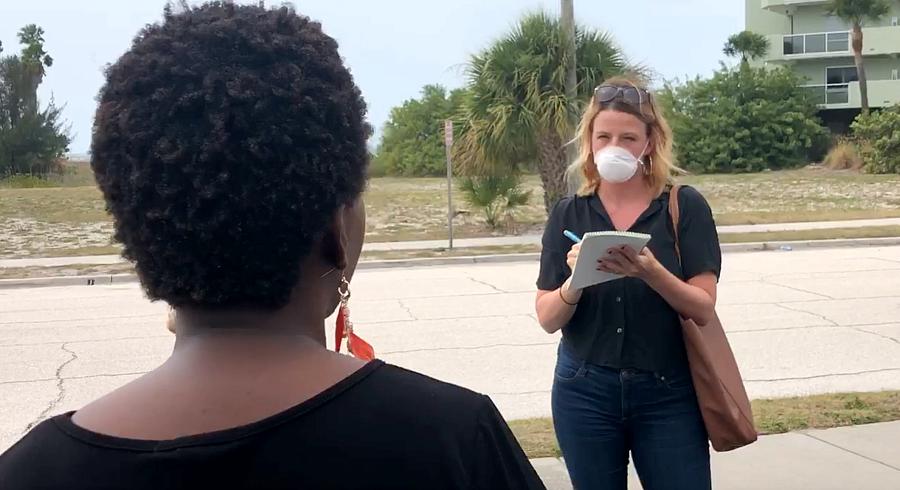A new Tampa Bay Times investigation will examine the unregulated dietary supplement industry

The author reporting in the field
Courtesy Image
While working as a restaurant critic and dining reporter for the better part of the last decade, I’ve been drawn to stories that probe the role that food industries play in people’s lives, especially as it relates to health and safety standards.
While reporting in New Orleans, I wrote stories about visually impaired service workers and substance abuse in the restaurant world. Here at the Tampa Bay Times, I’ve covered everything from discrimination and harassment in the brewing industry to the long-term health implications of COVID-19 for chefs and wine professionals.
Throughout my time on the beat, I’ve witnessed a number of trends infiltrate the food and beverage landscape, from no-tipping policies and avant garde culinary techniques to ghost kitchens and vitamin-spiked seltzers.
I’ve long been interested in how dietary fads influence public health discourse. The massive growth and success of the global wellness industry alone has shown that what we consume has become as much of a lifestyle choice as it is a personal statement — as central to our identity as what we wear or the political party we vote for. This has played out at restaurants, where an influx of gluten-free, vegan and adaptogen-friendly spots have found solid footing in the dining world and in the aisles of grocery stores and supplement retailers, where products aligned with a wellness focus and “clean eating” ethos are taking up an increasing amount of shelf space.
In recent years, a compelling new trend has emerged: unregulated dietary supplements that get marketed as a cure-all for physical ailments or substance use disorders where traditional Western medicines may have fallen short. In many cases, these products exist in a regulatory gray space with little to no government oversight. Though lacking approval from the U.S. Food and Drug Administration, they are still legal to sell in most states, available everywhere from electronic cigarette shops to health food stores and juice bars.
One substance in particular has piqued our interest and experienced explosive growth in the U.S. over the past decade, in particular with people who are dealing with chronic pain and other health challenges. Though legal to sell in most states, federal authorities have warned consumers about adverse health effects, including the potential for abuse and addiction.
But regulators have done little else to ensure the product’s safety.
I’m currently part of a reporting team at the Tampa Bay Times examining the growth of this substance in the U.S. market, the landscape that has paved the way for its success and its impact on consumers. As part of our reporting under the auspices of the 2023 National Fellowship, we are planning several in-depth stories about the industry that will cover these broad topics: who uses the product and its effects; how government regulatory structures work; and how the product is made.
There is a strong underlying assumption among consumers that a product with such widespread availability must be safe. But not all health professionals agree. This could leave consumers confused, unsure of proper dosing instructions or whether the product has the potential to interact negatively with any other over-the-counter medicines or prescription drugs they may be taking.
As recreational use of the substance has increased across America, much about its effects on people has flown under the radar. Our reporting will include a first-of-its kind analysis of hundreds of records to better understand who uses the substance; how and why it’s used; risks associated with use; and adverse outcomes attributed to the product.
We’re tracking demographic details on those who have had adverse outcomes to look for any patterns of inequity, or vulnerabilities.
We plan to examine the science of what this substance does to the body, how it interacts with other drugs or medications and what could be considered a particularly dangerous amount. We will vet our findings with many experts across disciplines, including toxicologists and pharmacologists.
We also plan to conduct our own testing of various products, looking for contaminants and other characteristics that could potentially make the substance riskier to use. Through this testing, we hope to get a better understanding of what could be passing through production processes to customers.
The substance occupies a controversial space in the public discourse, and because of its largely unregulated status, the current narrative on dosing, safety and efficacy has mostly taken place online. We will explore how the industry targets consumers and whether it markets the substance to any particular groups.
At a time when skepticism surrounding vaccines and modern medicine is at an all-time high, self-medicating with alternative remedies — often touted as “herbal” or “all-natural” — has become de rigueur. But without regulatory oversight, the general public is often left in limbo, not knowing whether the substance they’ve turned to for self-medication could potentially cause harm.
Through our reporting on this project, we hope to illustrate the scope and impact this industry has had as well as the ins and outs of the regulatory systems at play.

